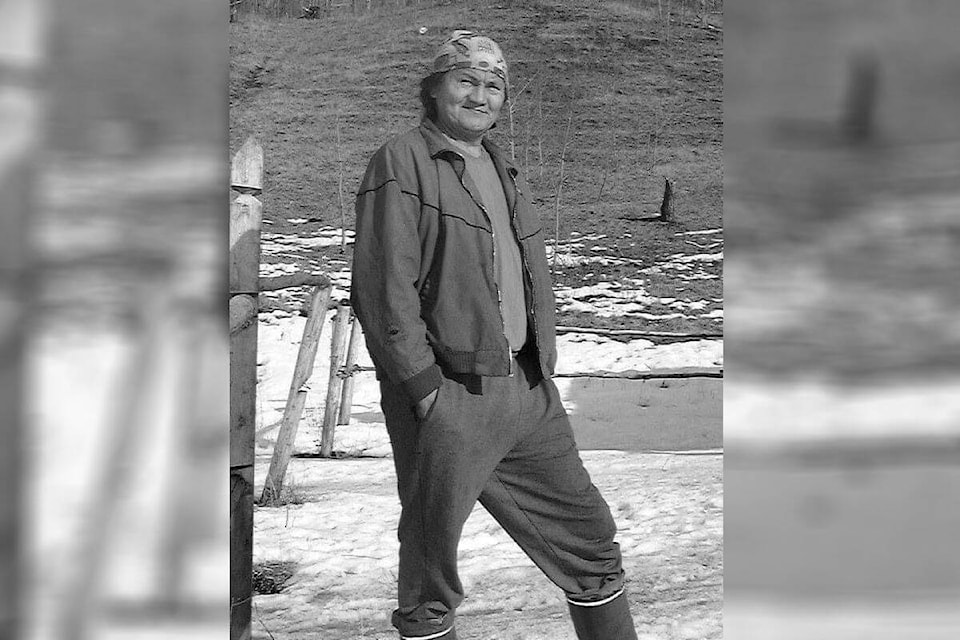Submitted to the Observer by Tina Alexis
Chief Roger served for over 30 years as Chief of Lhoosk’uz Indian Band. He was also a spokesperson and activist for his people. And most importantly, Chief Roger was a husband, grandfather, uncle, a brother, a cousin, a leader, a community member, a mentor, and a teacher.
Chief Roger was our very own Dakelh Philosopher. And finally, although, he didn’t hold the position for a few years, to many, he was and always will be “the people’s Chief.”
Chief Sojo, without question is one of our community’s strongest and most outspoken Dakelh leaders. He is also one of the last people to be mentored into such a position, the old Dakelh way.
READ MORE: ‘Fearless’ Lhoosk’uz Dené Nation chief remembered after death
In the old way, Dakelh children were mentored for certain roles and then mentored by elders and community members who held those roles. For Sojo, he was given the role of Chief. At the tender age of 19, mentored by the late Chief Peter Morris, Roger became the third Chief of the Lhoosk’uz Band and held that position for over 30 years.
Chief Roger wore his heart on his sleeve. While serving as Chief, he travelled throughout Canada and the world. Through his leadership role, he became involved with the National Indian Brotherhood (NIB), an organization founded to represent all “registered Indians.” Through this organization, Chief Roger worked closely with another great leader of our time, George Manuel.
In being connected with the NIB (now Assembly of First Nations or AFN), he became familiar with other Indigenous peoples’ struggles throughout the world. Through the NIB, he became involved with the World Council of Indigenous Peoples (WCIP), an organization founded by George Manuel.
Through the WCIP, Chief Roger came across the issue of the ALTA Dam in Norway. The situation was that the Norwegian Water & Energy company (like BC Hydro) had plans to build a dam and power plant on the Alta River in Northern Norway, a popular river Sámi Indigenous peoples used for salmon fishing and reindeer herding. Because the power plant and dam would disrupt Sámi Way of life (hunting and fishing) and displace their village, Sombbi planned to blow the dam in the opposite direction, however the explosive device malfunctioned and took his left arm and his hearing.
In fighting for Sámi Rights to land and water, Sombbi became a fugitive of justice and ended up in Clayidlee (formally Old Kluskus) at the homestead of Lloyd Boyd. However, because of close movements of the RCMP, Sombbi and his family moved to Nuxalk territory where the family was adopted by Nuxalk Law. The Sombbi family was also adopted by Sugar Cane, the Haisla, and Mowchaht communities through traditional protocols.
In the end, all charges were stayed because of insufficient evidence. Sombbi was able to return to his homelands where he currently lives and continues his advocacy in defending Sámi rights to land and water.
It is with issues like this, Chief Roger was passionate about, and yes, a true Indigenous Warrior he was.
READ MORE: 60 per cent of all Canadian Indigenous languages are in B.C.
Not only did he care about outside issues, but his passion was also with our very own people. We talked many times about this. He cared deeply for our own, including those living without homes and on the streets. We talked many times about the impacts of residential schools and how our family shouldn’t be displaced from our Keyoh (land), especially when we have a gold mine in our back yard.
Although Chief Roger worked at the mine for a short time, it was only for guardianship, “to ensure they were respectful in their work on our land.” Chief Roger was quoted in a Vancouver Sun interview stating, “you could say I may have a job, I have a truck and a fancy ski-doo, but you could say that inside, I am slowly dying.”
Chief Roger Jimmie’s tireless work as a Chief, a Warrior and community member will never go unnoticed, nor will his honesty ever be unappreciated.
As I talk with many people, and comrades, we are grateful for Chief Roger’s sacrifices. Some things he shared with myself and others is, “our ongoing struggle for freedom is not over, it is just the beginning, and we must become independent and return to our own lands and grow our own food. If you don’t do this in the future, you will starve.” Food security, according to Chief Roger is our next battle.
So, if I am ever asked about Chief Sojo — To me and many others, he is a Warrior. He is the Sitting Bull, Crazy Horse, Geronimo, Chief Seattle, and Cochise of our time.
He is a Lhoosk’uz and Dakelh leader, mentor, and teacher. He was a promoter of education, mentoring many of us “to be able to walk in the Whiteman’s world.” He is our very own Dakelh Philosopher. And of course, in books already published and books to come, his legacy will continue.
Uda dune hubulhinyalh. Cha nah nya getsein ts’ih (Walk with our ancestors. Everyone loves you).
Tina Alexis is Dakelh and a member of the Ulkatcho First Nation. She is a 3rd year PhD student in Indigenous Studies at the University of Saskatchewan. The article contributors are Lhoosk’uz knowledge keeper, Maureen Chantyman and Sámi political activist, Nillas Somby.
Do you have something to add to this story, or something else we should report on? Email: cassidy.dankochik@quesnelobserver.com
Like us on Facebook and follow us on Twitter.
